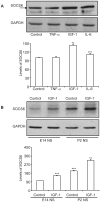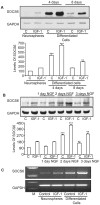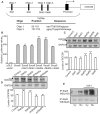Suppressor of cytokine signalling-6 promotes neurite outgrowth via JAK2/STAT5-mediated signalling pathway, involving negative feedback inhibition
- PMID: 22125600
- PMCID: PMC3219632
- DOI: 10.1371/journal.pone.0026674
Suppressor of cytokine signalling-6 promotes neurite outgrowth via JAK2/STAT5-mediated signalling pathway, involving negative feedback inhibition
Abstract
Background: Suppressors of cytokine signalling (SOCS) protein family are key regulators of cellular responses to cytokines and play an important role in the nervous system. The SOCS6 protein, a less extensively studied SOCS family member, has been shown to induce insulin resistance in the retina and promote survival of the retinal neurons. But no reports are available about the role of SOCS6 in neuritogenesis. In this study, we examined the role of SOCS6 in neurite outgrowth and neuronal cell signalling.
Methodology/principal findings: The effect of SOCS6 in neural stem cells differentiation was studied in neural stem cells and PC12 cell line. Highly elevated levels of SOCS6 were found upon neural cell differentiation both at the mRNA and protein level. Furthermore, SOCS6 over-expression lead to increase in neurite outgrowth and degree of branching, whereas SOCS6 knockdown with specific siRNAs, lead to a significant decrease in neurite initiation and extension. Insulin-like growth factor-1 (IGF-1) stimulation which enhanced neurite outgrowth of neural cells resulted in further enhancement of SOCS6 expression. Jak/Stat (Janus Kinase/Signal Transducer And Activator Of Transcription) pathway was found to be involved in the SOCS6 mediated neurite outgrowth. Bioinformatics study revealed presence of putative Stat binding sites in the SOCS6 promoter region. Transcription factors Stat5a and Stat5b were involved in SOCS6 gene upregulation leading to neuronal differentiation. Following differentiation, SOCS6 was found to form a ternary complex with IGFR (Insulin Like Growth Factor-1 Receptor) and JAK2 which acted in a negative feedback loop to inhibit pStat5 activation.
Conclusion/significance: The current paradigm for the first time states that SOCS6, a SOCS family member, plays an important role in the process of neuronal differentiation. These findings define a novel molecular mechanism for Jak2/Stat5 mediated SOCS6 signalling.
Conflict of interest statement
Figures











Similar articles
-
Endotoxin attenuates growth hormone-induced hepatic insulin-like growth factor I expression by inhibiting JAK2/STAT5 signal transduction and STAT5b DNA binding.Am J Physiol Endocrinol Metab. 2007 Jun;292(6):E1856-62. doi: 10.1152/ajpendo.00581.2006. Epub 2007 Feb 27. Am J Physiol Endocrinol Metab. 2007. PMID: 17327369
-
Hepatic growth hormone resistance during sepsis is associated with increased suppressors of cytokine signaling expression and impaired growth hormone signaling.Crit Care Med. 2006 May;34(5):1420-7. doi: 10.1097/01.CCM.0000215113.66070.E0. Crit Care Med. 2006. PMID: 16540952
-
MSM enhances GH signaling via the Jak2/STAT5b pathway in osteoblast-like cells and osteoblast differentiation through the activation of STAT5b in MSCs.PLoS One. 2012;7(10):e47477. doi: 10.1371/journal.pone.0047477. Epub 2012 Oct 11. PLoS One. 2012. PMID: 23071812 Free PMC article.
-
Role of SOCS and VHL Proteins in Neuronal Differentiation and Development.Int J Mol Sci. 2023 Feb 15;24(4):3880. doi: 10.3390/ijms24043880. Int J Mol Sci. 2023. PMID: 36835292 Free PMC article. Review.
-
Insulin-like growth factor-I receptor signal transduction and the Janus Kinase/Signal Transducer and Activator of Transcription (JAK-STAT) pathway.Biofactors. 2009 Jan-Feb;35(1):76-81. doi: 10.1002/biof.20. Biofactors. 2009. PMID: 19319849 Review.
Cited by
-
Progenitor cell combination normalizes retinal vascular development in the oxygen-induced retinopathy (OIR) model.JCI Insight. 2019 Nov 1;4(21):e129224. doi: 10.1172/jci.insight.129224. JCI Insight. 2019. PMID: 31672944 Free PMC article.
-
Expression of SHP-1 and SOCS6 in patients with acute leukemia and their clinical implication.Onco Targets Ther. 2017 Mar 29;10:1915-1920. doi: 10.2147/OTT.S131537. eCollection 2017. Onco Targets Ther. 2017. PMID: 28408843 Free PMC article.
-
High-throughput screen for compounds that modulate neurite growth of human induced pluripotent stem cell-derived neurons.Dis Model Mech. 2018 Feb 2;11(2):dmm031906. doi: 10.1242/dmm.031906. Dis Model Mech. 2018. PMID: 29361516 Free PMC article.
-
Growth condition controls on G-93 parameters of isoprene emission from tropical trees.J Plant Res. 2021 Nov;134(6):1225-1242. doi: 10.1007/s10265-021-01344-x. Epub 2021 Sep 9. J Plant Res. 2021. PMID: 34505187
-
Pharmacological Inhibition of Insulin Growth Factor-1 Receptor (IGF-1R) Alone or in Combination With Ruxolitinib Shows Therapeutic Efficacy in Preclinical Myeloproliferative Neoplasm Models.Hemasphere. 2021 Apr 30;5(5):e565. doi: 10.1097/HS9.0000000000000565. eCollection 2021 May. Hemasphere. 2021. PMID: 33954282 Free PMC article.
References
-
- da Silva JS, Dotti CG. Breaking the neuronal sphere: regulation of the actin cytoskeleton in neuritogenesis. Nat Rev Neurosci. 2002;3:694–704. - PubMed
-
- Goldshmit Y, Greenhalgh CJ, Turnley AM. Suppressor of cytokine signalling-2 and epidermal growth factor regulate neurite outgrowth of cortical neurons. Eur J Neurosci. 2004;20:2260–22660. - PubMed
-
- Goldshmit Y, Walters CE, Scott HJ, Greenhalgh CJ, Turnley AM. SOCS2 induces neurite outgrowth by regulation of epidermal growth factor receptor activation. J Biol Chem. 2004;279:16349–16355. - PubMed
-
- Krebs DL, Hilton DJ. SOCS: physiological suppressors of cytokine signalling. J Cell Sci. 2000;113:2813–2819. - PubMed
Publication types
MeSH terms
Substances
LinkOut - more resources
Full Text Sources
Molecular Biology Databases
Miscellaneous

